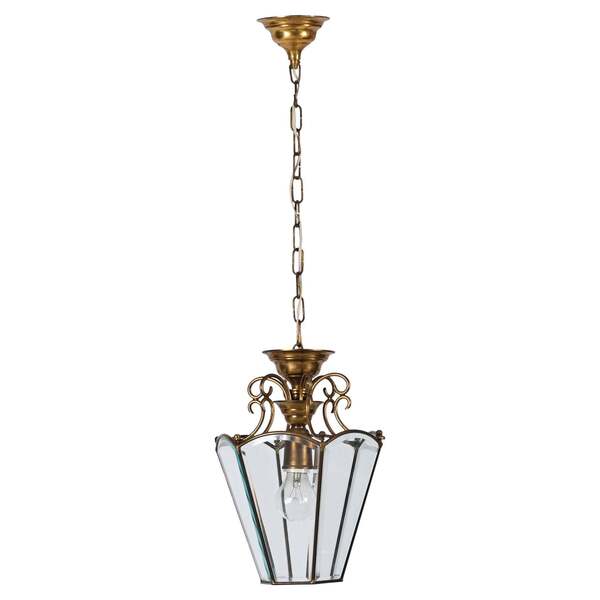Brass And Beveled Glass Hexagonal Italian Chandelier After Adolf Loos, 1950s
£1,236 per item
Shopping at Vinterior
-
14-day return guarantee
-
Outstanding customer service
-
Secure payment
-
Buyer protection
-
Trees planted for every purchase

Item details
Height
34.0 cm
Width
26.0 cm
Depth
26.0 cm
Diameter
26.0 cm
Wear conditions
Good
Wear conditions
Excellent
Shows little to no signs of wear and tear.
Good
May show slight traces of use in keeping with age. Most vintage and antique items fit into this condition.
Average
Likely to show signs of some light scratching and ageing but still remains in a fair condition.
Apparent Wear and Tear
Visible signs of previous use including scratches, chips or stains.
Please refer to condition report, images or make a seller enquiry for additional information.
Description
Superb brass and bevelled glass hexagonal chandelier. This amazing pendant light was designed in Italy and inspired by the work of Adolf Loos during the 1950s.
This piece is fantastic thanks to a splendid and clear suspension showing six faceted clear glasses in a brass frame. Although minimal in its design due to the hexagonal shape and the well-patinated brass material, the pendant conveys astonishing complexity.
This chandelier will be the perfect item for a neoclassic entrance hall or an art deco living room.
This item is in excellent condition with some signs of ageing and used as a brass patina, it comes with an E27 socket.
Adolf Loos (December 10, 1870 – August 23, 1933) was one of the most influential European architects of the late 19th century and is often noted for his literary discourse that foreshadowed the foundations of the entire modernist movement. As an architect, his influence is primarily limited to major works in what is now Austria and the Czech Republic, but as a writer he had a major impact on the development of 20th century architecture, producing a series of controversial essays that elaborated on his own architectural style by decrying ornament and a range of social ills. Adolf Loos’s minimalist attitudes are reflected in the works of Le Corbusier, Mies van der Rohe, and many other modernists and led to a fundamental shift in the way architects perceived ornamentation.
Born in Brünn in the Austro-Hungarian Empire (now Brno, Czech Republic) in 1870, Loos studied at the Royal and Imperial State Technical College in Reichenberg (now Liberec) until he left school to serve in the army for two years. Following this, he attended the College of Technology in Dresden and later moved to the United States for three years where he worked as a mason, a floor-layer, and a dish-washer. Eventually, Loos obtained a job working with architect Karl Mayreder in Vienna before establishing his own practice in 1897.
Through his writings, Loos desired to establish an intelligent method for designing buildings supported by pragmatic reasoning. His opposition to ornament extended to anything that could not be justified for its rational function. As a result, his buildings were often composed of pure forms and were justified by their economic practicality and utilitarian qualities. His theories on ornamentation were most succinctly revealed in an essay entitled Ornament and Crime in which he states “The urge to ornament oneself and everything within reach is the ancestor of pictorial art. It is the baby talk of painting... the evolution of culture marches with the elimination of ornament from useful objects.” Throughout the essay, he explored the notion that ornament results in the undue obsolescence of everyday objects, decrying the use of laborers and therefore financial capital for producing decorative details in contemporary buildings, and ultimately concluding that ornament was a sign of degeneracy.
His writings and architectural works sparked widespread furore, as they stood in sharp contrast to traditional Viennese design and more recent styles following the Vienna Secession and the Wiener Werkstätte. In writing a comparison between one of his most notable works and Josef Hoffman’s Apollo Candle Factory Shop, Loos alludes to the timeless qualities of architecture devoid of ornamentation: “The Cafe Museum, however, designed according to my principles and opened on the same date as the candle shop, will not become unusable until the glue no longer holds the furnishings together.”
Other notable buildings by Loos include his 1910 Goldman & Salatsch Building, overlooking Michaelerplatz, Vienna, as well as numerous private residences such as the Villa Müller in Prague. Many of his works, although controversial, revealed the roots of the modernist movement through their clean white walls and pure forms. Le Corbusier himself considered Loos’ Ornament and Crime "an Homeric cleansing" of architecture, revealing the magnitude of his impact on modernist ideology.
Condition report:
Good
Cancellations
We offer free cancellations and full refund for orders cancelled before dispatching. View full policy.
Returns
We have a 14-day return guarantee for orders from individual sellers, within the UK and European Union. View full policy.
Free collection available
Yes
Similar Chandeliers
Similar Chandeliers
More from this seller
More from this seller
Choose a Wishlist
Create Wishlist
- Ships from Roma, Italy
Cancellations and Returns
Last updated: 24th March 2025
We want everybody’s Vinterior experience to be seamless, so both buyers and sellers can fall in love with pre-loved. We designed our Terms of sale to treat everybody fairly.
However, sometimes things don’t go exactly to plan, and you may need to cancel or return an order.
To prevent this, we encourage you to check listings, photos and descriptions carefully before you buy. If you aren’t sure about a piece’s condition, size, provenance or shipping, just ask; click Contact seller to get in touch. Always contact your seller first if you have any queries, at any point in your purchase.
Our buyers receive the same protection when buying from all our sellers, both professional and verified.
Can I cancel an order?
There are many reasons why you might need to cancel an order, and you'll often be entitled to a refund. To cancel an order, click Create cancellation on the order page.
If you cancel your order before it has been dispatched, you will receive a full refund - including delivery costs. However, if your item has been shipped, delivery costs will not be included in your refund.
Please note: orders of bespoke, personalised or made-to-order pieces cannot be cancelled.
Can I return an order?
We understand that sometimes a piece isn’t the perfect fit. So if you no longer want your order, our returns process will ensure it finds a new home fast.
The Vinterior Guarantee included with your purchase entitles you to 14-day returns - allowing you to return any item within 14 days of the delivery date (except in specific circumstances, detailed below).
You can return your order if...
It isn't what you expected
If what arrives isn’t what you ordered, you can open a return. Just send us some photo evidence that the listing was inaccurate, misleading or misrepresented your purchased piece, and you’ll receive a refund.
You change your mind
If you don’t feel a piece is right for your space, you can return it. Once you request a change of mind return, you’ll be responsible for shipping the piece back to your seller as soon as possible. Delivery costs are non-refundable.
It's damaged in transit
In the rare event that an item arrives damaged or defective, you have a full 30 days from the date of delivery to return it for a full refund.
If your purchase arrives broken, always let us know. If Proovia delivered the piece, we can raise an insurance claim on the seller’s behalf. Or, the seller can raise a claim with their chosen courier.
What can't I return?
Just as there are some orders you can’t cancel, there are some you cant return, too. Personalised, bespoke or made-to-order pieces are non-returnable, and non-refundable. Sellers may also reject your return if the item has been altered in any way.
Please note: pieces on our site are pre-loved, not new. They may show some wear and tear; this is not sufficient grounds for a refund, unless the seller has misrepresented the item’s condition.
Lastly, neither Vinterior nor our sellers are liable for any damages or loss sustained in transit via third parties.
I'm eligible for a return. Now what?
To initiate a return, log into your Vinterior account, then go to the relevant order page and click Create a return. In the return request, be sure to include all the details: the reason for your return, an in-depth description, and photos of any issues or damage.
How will I receive my refund?
Once the seller confirms they’ve received the item (in the same condition it was sent), we will send your refund to your original payment method.
All items are inspected on return. If the seller receives the return with damage they don’t recognise, we will not be able to process your refund and the seller may need to send the piece back to you. You will be required to cover these delivery costs.








